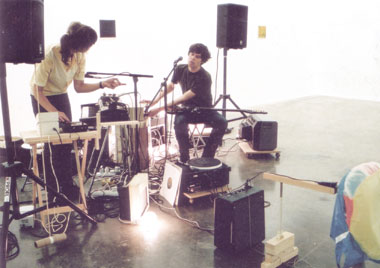You perform in both music and art contexts as well as creating installations: do you draw a distinction between the live performance / music and the sound art / installation side of your practice?
Even though they are separate platforms, all our activities inform each other quite naturally. Sometimes songs grow out of what was a simple sculptural happening and other times parts of songs are integrated into structures. We never try to force anything to exist where it doesn’t belong.
Do audiences and their responses differ in the two contexts?
Live performance is such an immediate situation for both maker and receiver, which we try to utilise to create a spontaneous set of events. This is also something we utilise in our sculptural work, although it is a more controlled environment where the events that occur have gone through a longer process. Generally, the fleeting, volatile nature of sonic events naturally posits themselves differently to time than physical objects do. Within visual thinking, time is quite manageable and provides space for a series of intellectual hesitations, whereas sound, with its immediate relationship to time, demands a more direct and spontaneous relationship with material. This fluidity with material is something we value and try to maintain in our practice at large.
A review of Nina’s show at Motherstankstation spoke in terms of manipulation of sound as though it were a sculptural material. Do you think this is an interesting way to think about your work?
This kind of thinking is an integral part of my practice, and I consider myself a sculptor in most aspects of the things I do, even though the final outcome might not always result in a typical three-dimensional structure. I see sculpture as a very open practice. In contrast to audio-art which foregrounds perceptual effects, technological progression, and self-referentiality, I am interested in engaging with acoustic phenomena as a catalyst for collective imagination, the construction of a magical image and affinities for extended habits of listening.
How important is improvisation to your live performances?
Improvisation is a key to keep any act open to the possibilities of what might occur. In live situations we intentionally create open spaces in between more structured points, in order for us to become two components in a larger machinery which trigger and join up a set of sonic and sculptural actions. We need undefined structures to stay engaged with what is being performed.
With your installations, to what extent does the work relate to the space it is exhibited in? Is the work entirely pre-planned in the studio or is it adapted to or derived from the space it is shown in?
It varies on the nature of the project, but we always pre-plan in the studio with prototypes, even when we are preparing for a more site-specific work.
Sometimes I think that ‘fine art’ that uses sound is one of the most esoteric media, whereas music is one of the most accessible; do you think this is true?
I guess what is commonly defined as ‘music’ often resembles entertainment, and so as a consequence it is seen as having more financial potential and allows for easier distribution than the more conceptual approach of an artistic practice. As with any kind of subject, at some stage one gives up on the most common denominators and clichés in search for more interesting ways of utilising or experiencing the given medium. As long as the general public are content with what is accessible, that music will stay accessible. But there are many interesting crossovers and there has never been a time when so much esoteric media has been so accessible.
Nina, when I spoke to you at the Bring the Noise performance (at Catalyst Arts) you seemed to hate most of the artists I mentioned! So what artists or musicians do you most admire?
I can’t say I hate any artist’s or musician’s practice, and there are certainly a number of artists, thinkers and musicians who I admire with great respect. People and activities which one can experience in real life generally inspire more than those at a distance.
Niall de Buitléar is an artist currently based at Flax Art Studios, Belfast.
